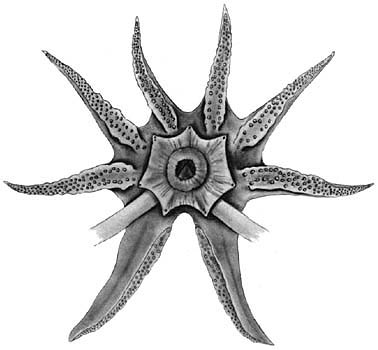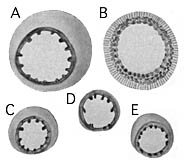Bathyteuthis abyssicola
Clyde F. E. RoperIntroduction
This deep maroon-colored squid inhabits the meso- and bathypelagic zones of all oceans of the world. It is particularly abundant in the Southern Ocean where it seems to be the dominant small deep-sea squid. Bathyteuthis remained monotypic from the time of its discovery by the famous Challenger Expedition until 1968 when two additional species were recognized and described (Roper, 1968).
Characteristics
- Arms
- Protective membranes low, fleshy, without free trabeculae.
- Arms short, not attenuate; tips blunt.
- Arm suckers relatively few in number, about 100 on each of arms I-III.
- Arm sucker rings with 8-18 separated, bluntly rounded to truncate protuberances.
- Tentacles
- Tentacles and clubs relatively short.
- Head
- Beaks: Descriptions can be found here: Lower beak; upper beak.
- Beaks: Descriptions can be found here: Lower beak; upper beak.
- Gills
- Gills short, narrow.
Nomenclature
Bathyteuthis abyssicola was described in 1885 by Hoyle. Benthoteuthis megalops was described by Verrill, also in 1885. These species were recognized as being the same entity, but both names continued to be used for years because no firm date of priority for publication had been established. In 1900, Pfeffer finally synonymized Benthoteuthis megalops with Bathyteuthis abyssicola at the same time he erected the Family Bathyteuthidae. The actual dates of publication of these two species were not verified until 1969 when it was established conclusively that B. abyssicola had priority by two months (Roper, 1969).
Life History
Paralarvae of 4 mm ML have very small, paddle like, subterminal fins; strongly protruding, anteriorly directed eyes; extremely short, stubby arms with 6 minute suckers paired in 2 longitudinal series on arms I-III and 5 suckers in a zigzag row on arms IV. Tentacles are relatively long and clubs are undifferentiated with 18 minute suckers paired in 2 longitudinal series at the distal end. Immediately proximal to the suckers are 16 knob-like bumps paired in 2 longitudinal series that are precursors to suckers. By 6 mm ML the fins are much better developed, the very small photophores are developing on the aboral bases of arms I-III, and the tentacular suckers are in 5-6 longitudinal series along the club (Roper, 1969).
Distribution
The type locality for this species is in the southern Indian Ocean between the subantarctic islands of Crozets Is. and Prince Edward Is.
Vertical Distribution
This bathypelagic species normally occurs at 700-2000 m, but records are given as 100-4200 m; the greater depths probably are artifacts from open (non-closing) sampling nets. Paralarvae and juveniles live at shallower depths than adults. In the Southern Ocean (Antarctic Ocean), the population undertakes a deep diel vertical migration (Roper, 1969). The population in the eastern tropical-subtropical North Atlantic also demonstrates a diel vertical migration (Clarke & Lu, 1975; Lu & Clarke, 1975).
Geographical Distribution
Bathyteuthis abyssicola is cosmopolitan in the world oceans. It is circumpolar in the Southern Ocean and in the highly productive waters of the eastern Pacific, the Atlantic, and the Indian Oceans (Roper, 1969).
References
Clarke, M.R. & C.C. Lu 1975. Vertical distribution of cephalopods at 18° N 25° W in the North Atlantic. Journal Marine Biological Association of the United Kingdom, 55: 165-182.
Hoyle,W.E. 1885. Narrative of the Voyage of the Challenger Expedition. The Cephalopoda. Report on the Voyage of HMS Challenger (1873-1876), 1 (1): 269-274.
Lu, C.C. & M.R. Clarke. Vertical distribution of Cephalopods at 11° N 20° W in the North Atlantic. Journal of the Marine Biological Association of the United Kingdom, 55:369-389.
Roper, C.F.E. 1968. Preliminary descriptions of two new species of the bathypelagic squid Bathyteuthis (Cephalopoda: Oegopsida). Proceedings of the Biological Society of Washington, 81:261-272.
Roper, C.F.E. 1969. Systematics and zoogeography of the worldwide bathypelagic squid Bathyteuthis (Cephalopoda: Oegopsida). Bulletin of the United States National Museum, 291:1-210.
Verrill, A.E. 1885. Third catalog of Mollusca recently added to the fauna of the New England coast and the adjacent parts of the Atlantic, consisting mostly of deep-sea species with notes on others previously recorded. Transactions of the Connecticut Academy, 6(2): 395-452.
Title Illustrations

| Scientific Name | Bathyteuthis abyssicola |
|---|---|
| Location | Ross Sea, Antarctica at 67°37'S, 178°55'W |
| Creator | Darren Stevens |
| Acknowledgements | New Zealand part of the International Polar Year and the Census of Antarctic Marine Life |
| Identified By | Darren Stevens |
| View | Dorsal |
| Size | ? mm ML |
| Collector | LINZ |
| Image Use |
 This media file is licensed under the Creative Commons Attribution License - Version 3.0. This media file is licensed under the Creative Commons Attribution License - Version 3.0.
|
| Copyright | © D.Stevens NZ IPY-CAML |
About This Page

Smithsonian Institution, Washington, D. C., USA
Page copyright © 2017
All Rights Reserved.
- Content changed 10 October 2017
Citing this page:
Roper, Clyde F. E. 2017. Bathyteuthis abyssicola . Version 10 October 2017 (under construction). http://tolweb.org/Bathyteuthis_abyssicola/19432/2017.10.10 in The Tree of Life Web Project, http://tolweb.org/













 Go to quick links
Go to quick search
Go to navigation for this section of the ToL site
Go to detailed links for the ToL site
Go to quick links
Go to quick search
Go to navigation for this section of the ToL site
Go to detailed links for the ToL site